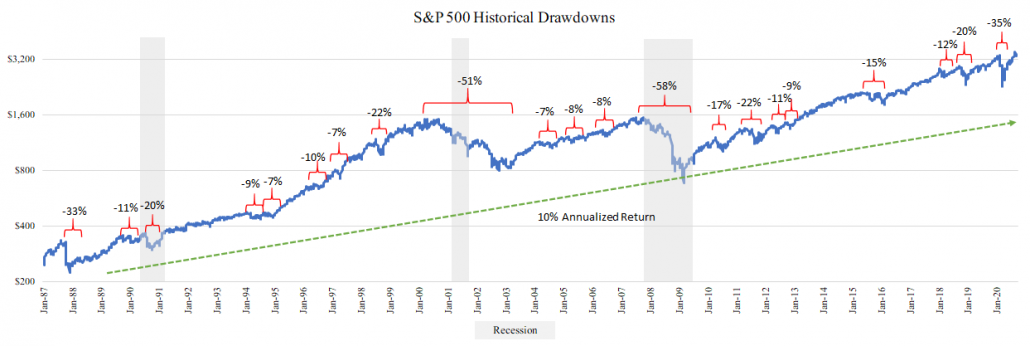Timing the market?
Chris Broome – Chartered Financial Planner
At Longhurst we work alongside investors no matter what stage of their wealth accumulation journey.
This includes those at the very beginning, through to those who have already achieved their version of financial independence and are now looking to preserve their wealth.
When we first meet a prospective new client sometimes we establish that some of them have been self-investing, adopting an approach of attempting to time the markets and what stocks to pick.
Backed by empirical data, the following article perfectly distils the truth about attempting to time the markets and pick the winning stock.
- Over the past 30 years, the Standards & Poors 500 Index provided a 10% compound annual growth rate. This generated a large amount of wealth for those who participated despite there being 4 recessions, of which 2 were great market bubbles of the past century and a very well-known global pandemic.
- Despite this favourable result, very few investors fully participated. Equity fund investors underperform the market by a huge margin. Blackstone produced a report in which they showed that even though the average equity mutual fund in the U.S. averaged 8.2% annually,
- Investors who invested in these funds averaged only 2%. Another study showed the average equity investor return has underperformed the market by over 4% annually. These significantly lower returns are largely a result of the natural human tendency to chase performance,
- and avoid any setbacks i.e. trying to time the market. The error of omission by not investing in stocks in an attempt to time the market has likely lost investors more money than any realized losses themselves.
- Even with the long-term upward trend, the stock market is littered with frequent drawdowns, corrections, and bear markets. There is a 10%+ correction every two years on average, and about half of those will be a 20%+ decline, which have occurred every four to five years.
- Since these drawdowns occur regularly, people attempt to avoid these declines by buying and selling based when they “feel” a correction is about to happen. Of course, average is not a fixed time frame. There can be long periods with little downward movement.
- Maybe after 2-3 years of strong returns, commentators will start saying we are due for a correction, suggesting investors should move to cash.
- Perhaps another 2-3 years will pass with strong market returns as one waits on the side-lines trying to control feelings of missing out on easy money, ready to buy back in at the first sign of a down market.
- Not only do investors often hold cash in fear of future corrections, during such drawdowns it is common for them to sell what stocks they own in an effort to protect their wealth, waiting for the bottom to pass…a double whammy to long-term returns.
- During the crash in March, we heard many say they believe stocks will be worth far more than current prices in five or ten years, but they think stocks have not bottomed yet so are waiting for another 10-20% decline before buying.
- The thing about market bottoms is they are only known with the help of hindsight. It is a big mistake to look at what is going on in the economy today and then decide whether to buy or sell stocks.
- A bad economy and down market can be your friend if it provides an attractive investment opportunity. It does not make a lot of sense to wait to buy into a great business at an attractive price for the potential that it gets more attractive tomorrow.
- One should decide whether to buy or sell stocks based on how much they are getting for their money, as in where shares are trading relative to their intrinsic value. The important thing is to have the right long-term outlook.
- Some may argue that as the risks of the pandemic grew more apparent in mid-February the prudent thing would be to sell or hedge one’s positions.
- This same logic could be applied to selling when risks of the Chinese trade war arose, potentially rising interest rates, or the numerous other headline risks that appear frequently.
- This reasoning also misses the point that one is able to sell near market highs and buy back in at the lows with full clarity.
- Maybe there does exist a token few investors that are talented market timers, better at knowing what people’s emotions will be tomorrow than others, though we remain sceptical.
- Phil Fisher may have said it best, “I had seen enough of in an out trading, including some done by extremely brilliant people, that I knew that being successful three times in a row only made it that much more likely that the fourth time would end in disaster…
- The risks were considerably more than those involved in purchasing shares in companies I considered promising enough to want to hold them for many years of growth.”
Want to talk?
Please get in touch if you’d like to discuss this article or indeed your own financial planning requirements.
Note
The content of this page was produced by an US based company called Saga Partners.
We thank them for sharing great insight which we clearly agree with.




